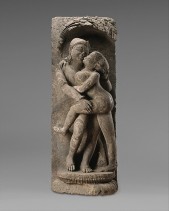Culture, religion, and materials have dictated art throughout the ages.

Culture and religion mainly drive the difference between western art and non-western art. Visit a temple in India. Instead of statues of saints or frescoes depicting Biblical stories, you will find many erotic scenes in the form of sculptures. This is due to the Hindu belief that spirituality of a man and a woman is made complete with the joy of sensual pleasure of erotic love. To convey this to their disciples, scenes of erotic love augment sculptures of Hindu deities.
Hinduism, as it is known now, emerged at about the time that Christianity started. The religion is mixed and complex, with no single founder, no single spokesman, or no single prophet. There is an emphasis on the preeminence of the gods Vishnu and Shiva, along with the goddess Shakti (literally, “Power”). The sculptures of these deities have a perception of movement to them.


I chose these two pieces of Vishnu to show his different personas, a protector and a welcoming god. I am impressed by the detail of the pieces. I can almost feel the strength of Varaha emulating from his thighs and chest as he devours the primeval serpent monster and rescues the goddess Bhudevi (earth), who is hanging from his tusk. His figure look so masculine and strong. The look of adoration from the surrounding figures for defeating the serpent demonstrates how they look to him for protection. The outstretched arm and the relaxing pose of the four-armed Vishnu provide a calming presence.
Bronze was introduced as a material for statues during the 9th century CE, becoming the standard around the 11th century. It is now the traditional material for the dancing figure of Shiva.

The fact that they created such an intricate piece from bronze in the 11th century astounds me. The piece has such fluid movement to it – the flowing ribbon, leg and arm movements, and the different rhythms within the flames. One can almost hear the music playing in the background.
The lone goddess I am portraying is Parvati. Parvati is the gentle and nurturing aspect of the goddess Shakti.


I chose these two pieces to represent Parvati. The stone sculpture from Orissa has such intricate details carved in the stone. The painstaking detail of the ornate jewelry allows you to see each stone distinctively. Although time has worn away some of the details on “Kalyanasundara- the marriage of Shiva and Parvati,” I can see the outlines of the ornate jewelry here also.
Though the temple art of India is far different to the art of Roman Catholic churches, it is no less interesting. It speaks of their East Asian culture and their belief system. Their convictions to their religion are no less than Europeans convictions. They, too, choose to adorn their places of worship with art that tells the stories of their religion and show their disciples how to live within their beliefs.
Works cited:
Cartwright, Mark. “Vishnu”. Ancient History Encyclopedia. http://www.ancient.eu/Vishnu/. November 25, 2012. Accessed April 10, 2016.
Cartwright, Mark. “Shiva Nataraja – Lord of the Dance”. Ancient History Encyclopedia. http://www.ancient.eu/article/831/. September 8, 2015. Accessed April 10, 2016.
Unknown. “Parvati”. Wikipedia – The Free Encyclopedia. https://en.wikipedia.org/wiki/Parvati Accessed April 10, 2016.
Dehejia, Vidya. “Hinduism and Hindu Art.” In Heilbrunn Timeline of Art History. New York: The Metropolitan Museum of Art, 2000–. http://www.metmuseum.org/toah/hd/hind/hd_hind.htm February 2007. Accessed April 7, 2016.
Shrestha, Prajwal. “Non-Western Art”. Art Appreciation. http://appreciationofarts.blogspot.com/2011/07/non-western-art.html. July 17, 2011. Accessed April 7, 2016.
Nice blog! I like how you demonstrate the difference between western and non-western art and the influence of the different belief systems. My favorite piece in your blog is the statue of dancing Shiva, I love how flowing the figure looks. They did an excellent job of capturing the motion.
LikeLike
Great job! I didn’t know that much about Hindu art like this so it was definitely interesting. I didn’t know there was that much of a difference in western religious art and eastern, but you did a good job at showing that difference. I think that my favorite piece here is the Shiva Nataraja – Lord of the Dance statue. Like you said, it’s amazing that they could make something so complex back then. It would be really cool to see in person. Other than that I can’t think of anything really that is missing from this blog.
LikeLike
Great job. I liked how you made the connection between religion and art. I didn’t quite realize what a huge difference it made in the style of art until you pointed it out. My favorite piece was the Shiva Nataraja – Lord of the Dance statue. I love the detail and the way if naturally flows outward.
LikeLike